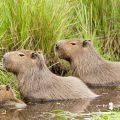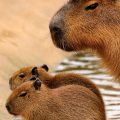Table of Contents
Are you an exotic pet enthusiast? Or is planning to be one? Well, behold because capybaras can be your new exotic pet raising venture. Capybara are the new, rising exotic pet to own; that is loved and praised deeply by the ones that are already in peace raising them. Why? Because these giant rodents; which are easy on the eyes because of their unique cuteness have a semi-aquatic lifestyle with a friendly, affectionate, highly trainable endearing demeanor; that manifests most dog’s characteristics, moreover, they have a very interesting yet low maintenance lifestyle.
So, how do you take care of capybaras, if you are about to venture on your responsible, exotic pet ownership? This article will teach you about their shelter, diet, and healthy lifestyle maintenance in captivity.
Capybara Shelter
Capybara are the world’s largest rodents. Their shelter should be big, to cater to their massive size comfortably (at least 12 feet by 20 feet). Their shelter should be customized; it should mimic the natural environment by providing plants; and by providing a much-needed pool (4 cm minimum water level) for them since they are semi-aquatic animals. They need water at all times to dip themselves in, also; keep the chlorine in it at a minimum since they drink water in it as well. Overall, it is an effective shelter if it has room for food, water, roaming and playing, urinating, and defecating.
In addition to that, their shelter should be outdoor, where they can catch the sunlight. Provide shade for them as well. Their shelter should be secured and made sturdy, a cement wall, with a hard metallic mesh; is encouraged to ensure that it will not escape.
You should consider getting two capybaras at times since they are highly social animals that need companions; although they really get along with other pets such as cats, dogs, ducks, and monkeys. They need not be alone, as they can get sad, anxious, stressed out, and depressed.
Capybara Diet
Capybaras are herbivores and like to binge eat grass, and greenery plants. In the wild, they like aquatic plants as well. In captivity, you can feed them grass (free from pesticides and chemicals) and hay; and should be supplemented with fruits and vegetables for optimum health since they both hold great nutrients that are beneficial for their growth; overall health, and well-being. Fruits and vegetables should take up 30% of their diet.
Like other rodents, capybara too continuously through their life grows their teeth. Provide them branches, hay, wood, and other course objects for them to chew to file their pearly whites with. This is a must because if they do not file their teeth down, it will lead to overbite; that will lead to mouth disfigurement and tooth and gum ache.
Their bodies do not produce sufficient vitamin C. Aside from fruits and vegetables, you can also give the guinea pig pellets to assure they will not have a vitamin C deficiency.
They should eat two times a day; the first meal at dawn, and the other in the late afternoon, with them chewing on some branches, hay, or wood in between. Also, they eat their own feces in the morning; to help aid in their digestion since grass is hard to digest.
Capybara Lifestyle Maintenance
They need to swim regularly, so a pool that will allow them to swim comfortably is non-negotiable. It is a form of exercise as well.
They need to have a companion to thrive preferably one of their own or any other house pets you have. If you are a busy owner, keeping them alone will cause them distress, anxiety, and sadness.
Of course, you as their owner and main caregiver should make time for them; to form a strong bond between the two of you, to form an affectionate relationship.
They can urinate and urinate in the pool area at times, so cleaning it, preferably two times a week will ensure hygiene and safety from germs and bacteria.
To Pet or Not to Pet?
As they become close to you, they at times like gentle petting. Gentle petting is good for their mental health and happiness level. To do this, hold them with your hand and arm under their belly and the other hand under their neck; do not grab them by their hind legs as they might be dislocated. Cuddle and pet them gently as they settle onto you.
Capybaras are prone to respiratory infections as well as infestation of mites and lice; these two can be prevented by having a shelter that is sanitized and clean at all times. You can spot clean them every day or deep clean them two times per week.
To regularly monitor your capybara’s health, once a year, do invite a veterinarian that specializes in exotic pets. This is to ensure and validate the great condition it shows, and this will be helpful in ruling out undiagnosed medical health conditions if there exist any.
As for the warning signs that need immediate medical attention, they are drooling, excessive diarrhea, lethargy, scratching in the mouth or face, distressed breathing, muscle twitching, and seizure. Upon seeing these signs, the next right thing to do is to call help from a veterinarian.
Conclusion
Capybara as exotic pets can be fascinating, moreover a great fulfilling experience. To get started, make sure that capybara raising in your state is legal, as legality plays a crucial role in securing them as your pet. Once it is settled, you can go ahead and apply all of our effective advice, and get going on your way to responsible exotic pet ownership.






 Author and long-time animal lover. Sharing knowledge on pet care through experience and the written word.
Author and long-time animal lover. Sharing knowledge on pet care through experience and the written word.